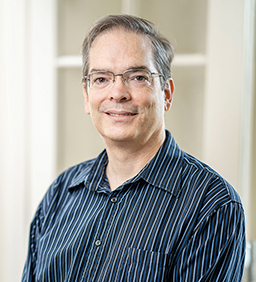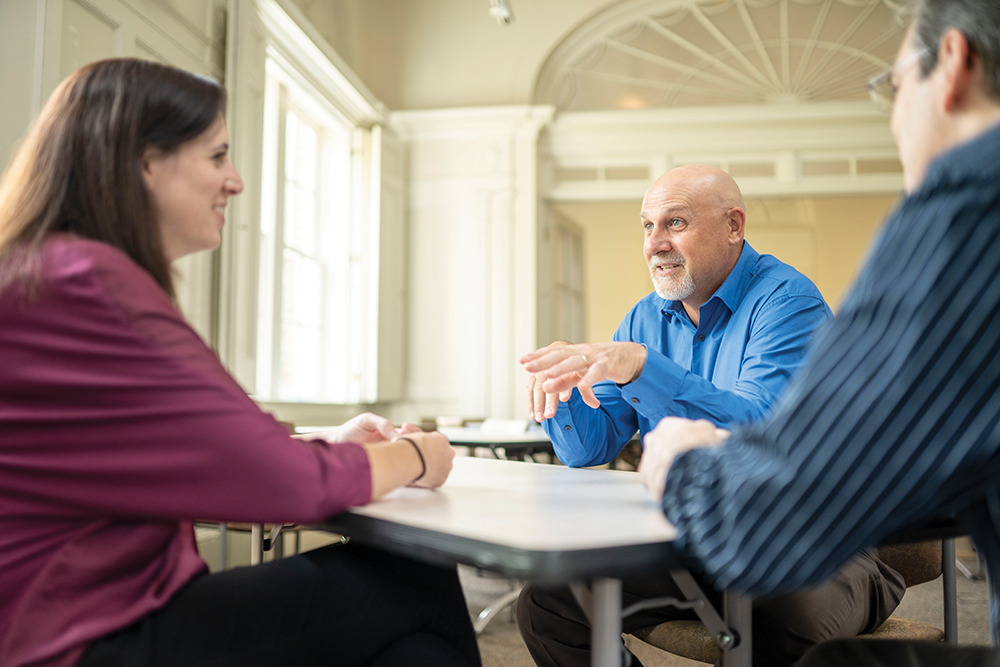
“I want to help you.”
In a moving but chilling scene, that line is uttered by HAL 9000, the all-knowing computer system depicted in the classic 1968 film 2001: A Space Odyssey, as it pleads with Dr. Dave Bowman not to disconnect the rogue machine for the final time.
Now, more than a half-century after that movie was released, a group of interdisciplinary researchers from across Vanderbilt University believe HAL may have been onto something—minus the menacing dystopia. They’re leading a new effort to recast computers as integral knowledge partners across a range of subject areas, not simply as monolithic tools reserved for high-level programmers.

The Computational Thinking and Learning Initiative, one of five new Trans-Institutional Programs announced this year, seeks to better incorporate computer-aided thinking skills into the classroom among both students and teachers, says Corey Brady, assistant professor of learning sciences at Peabody College and assistant professor of computer science in the School of Engineering.
“There hasn’t been enough work to think about how to apply computational methods innovated in one area to another, and about how these different disciplines’ use of computers gives us a more holistic sense of what a computer is capable of,” says Brady, who leads the initiative at Peabody. “In the educational world, how do you prepare people for that kind of computational thinking?”
The Vanderbilt team driving the initiative describes computational thinking (CT) as the capacity to frame, analyze, disaggregate and reconfigure problems in a way that leverages the ever-expanding capacities of computers. The goal is to develop a fluency among researchers and students that allows them to augment how they approach discovery, whether in the hard sciences or the creative arts.
“The idea is to think about the computer not as a black box tool, but as a kind of partner in solving problems,” Brady says. “And, in part, the value of that partner is that it doesn’t think like you. A key reason you partner with someone is that they think differently from you, and the computer is a pretty dramatic case of that.”
Going beyond computer class
Guiding teachers to bring computational thinking lessons more naturally and powerfully into classroom instruction beyond the computer lab is key to the initiative, the researchers say.
“The most critical challenge is the lack of teachers who can teach computing or feel comfortable teaching computing,” says Akos Ledeczi, PhD’95, professor of computer engineering in the School of Engineering and a member of the Computational Thinking initiative. “Once we have that, teaching the students will be much easier and more scalable.”

Lack of teacher preparation in computational thinking skills has reached crisis levels, says Heather Johnson, associate professor of the practice of science education at Peabody, particularly in a state like Tennessee, which is implementing new computer science standards for students this year.
For many teachers, computational thinking “isn’t their first love,” says Johnson. “Most are learning as they go. But they’re the best people to understand that computation has value in a discipline.”
Most teacher training programs lack trajectories for licensing teachers in computational thinking skills. In fact, only one teacher candidate in the entire state of Tennessee last year qualified to teach K–12 computer science. But in the preservice coursework at Peabody, more of these concepts are being woven into the curriculum.
“Our teacher candidates now have more opportunities to think with the computer,” Johnson says. “They can then reflect on their own experiences and consider ways to bring those same concepts into the K–12 classroom.”
Not just for math and science
Brady says integrating computational thinking across many different walks of society will become increasingly important. “We want to integrate CT at all levels,” he says, “in all subject matters, rather than simply trying to find another period in the day just to teach computational skills.”
With the right training and tools, he says, teachers soon realize that formulating questions based on computational thinking and devising programs to answer them help students understand basic concepts better than rote memorization of formulas. The reason why is that it engages students in “primary inquiry,” utilizing problem-solving skills, constructing arguments, and developing evidence-based explanations. In short, they begin exploring disciplines much as experts would.
“The trick with using computational thinking in the classroom is to give the teacher the confidence and the tools to allow the kids to actually create models to test and refine their intuitions,” Brady says.
“The idea is to think about the computer not as a black box tool, but as a kind of partner in solving problems. And the value of that partner is that it doesn’t think like you.”
—Corey Brady
Undergraduates understand the importance of digital competency in today’s workplace, fueling the skyrocketing demand for at least some computer science classes, as well as an increase in majors and minors in the subject. As a result, existing resources are being taxed.
“Most disciplines are being transformed by computing,” Ledeczi says. “But that does not mean students in these disciplines have to become software developers.”
To meet the growing need, members of the Computational Thinking initiative have already designed an entry-level computer science course for nonmajors (CS 1000) using a visual learning program to introduce the field’s basic concepts and to explore its potential social impact.
Climate change is one area that increasingly utilizes large and growing data sets tracking historical and real-time weather and climate data, Brady explains. Students can use the computer to become detectives, ask questions, formulate theories of causality, and change and build explanatory models.
“We can put the current climate crisis in a context that spans millions of years,” Brady says. “This creates the opportunity for data-visualization questions and also provides grounds for students to create models for what they believe causal relations might be, test them against historical data, and project their findings into the future.”
CT initiative member Lynn Ramey, professor of French, chair of the French and Italian department, and faculty director of the Center for Digital Humanities, is part of a research group developing language-processing systems to help students analyze text while also learning computational thinking strategies. For example, students might use a CT-inspired computer program to analyze a poem’s “affect,” the emotional effect of the poem and the sentiments it arouses.
“There’s a stamp that authors unconsciously put on their work,” says Ramey, who specializes in medieval literature. “When you write in that style, it’s not always easy to figure out, but a computer can help identify all these different markers.”
In her work Ramey analyses centuries-old texts, often unsigned, to determine if they could be the work of a certain author. Her special interest is Marie de France, who may have been the first female French poet.
Ramey hopes to capture the interest of students who love literature, raising their comfort level with computational methods. “Maybe they will go on to do great things beyond the simple stuff,” she says.
Such strategies for processing literature are introduced most naturally in the classroom as early as middle school, when students begin writing longer essays and arguments, and could help form a useful basis for later work, Brady says.
“Kids start thinking about their audience, the rhetorical function of text, and their own style as a writer,” he says. “These concepts obviously become even more important at the undergraduate level.”
The goal is to encourage students to think with computers, and that process comes with challenges—hopefully none as dire as in 2001: A Space Odyssey—but just enough to push the boundaries of learning and research.
“This is still an area of pretty high discovery,” Brady says. “It’s not always completely clear how to create learning partnerships between computers and people. In fact, in education, sometimes the computer should make the student’s job harder. Sometimes those difficult moments are actually really important learning moments.”

The Computational Thinking and Learning Initiative Faculty
Corey Brady, assistant professor of learning sciences, Peabody College, and assistant professor of computer science, School of Engineering
Noel Enyedy, professor of science education, Department of Teaching and Learning, Peabody College
Heather Johnson, associate professor of the practice of science education, Department of Teaching and Learning, Peabody College
Akos Ledeczi, professor of computer engineering, School of Engineering
Gautam Biswas, Cornelius Vanderbilt Professor of Computer Science, Computer Engineering and Engineering Management, School of Engineering
Jonathan Gilligan, associate professor of Earth and environmental sciences, College of Arts & Science, and associate professor of civil and environmental engineering, School of Engineering
Ole Molvig, assistant professor of history, assistant professor of communication of science and technology, College of Arts & Science
Lynn Ramey, professor of French, College of Arts & Science, and faculty director, Digital Humanities Center
Chris Vanags, director of research initiatives, Peabody College, and research assistant professor of Earth and environmental sciences, College of Arts & Science
Cliff Anderson, associate university librarian for research and learning; professor of religious studies, College of Arts & Science; and adjunct professor of computer science, School of Engineering